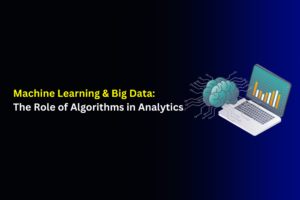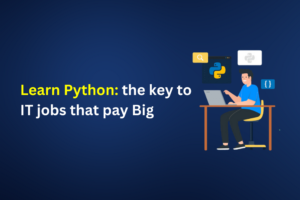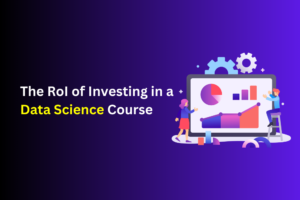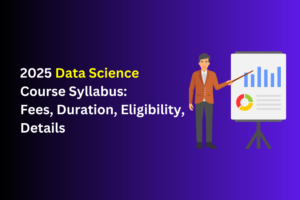Have you ever wondered how Netflix suggests videos tailored to your preferences? Or how Facebook automatically tag familiar faces in photos? What about how banks pinpoint loyal customers and predict which ones might switch to a competitor? And how has the process of drug discovery become more efficient? These are all powered by data science. By enrolling in a data science course, you’ll explore these fascinating phenomena and learn how they function behind the scenes.
The area of data science is vast and multidisciplinary and combines elements of statistics, mathematics, and information technology. A typical data science course syllabus covers both foundational and advanced topics, including data analytics, statistical methods, machine learning, and programming languages like Python or R. It equips you with the skills to analyze large datasets, identify meaningful patterns, and build predictive models that drive decision-making.
If you’re considering pursuing a data science course and are curious about what the syllabus entails, this article will provide you with all the details you need to get started.
What is Data Science?
A data science course syllabus integrates programming, domain expertise, and knowledge of mathematics and statistics to derive valuable insights from data. Data science professionals utilize machine learning algorithms to analyze diverse types of data, such as images, numbers, text, video, and audio, creating artificial intelligence systems that perform tasks that typically require human intelligence. These AI systems generate insights that business analysts and decision-makers can leverage to create substantial business value.
Every data science model follows a structured life cycle that generally includes these six key steps:
- Data Acquisition: Gathering data relevant to the business problem at hand.
- Data Preparation: This stage involves cleaning, transforming, processing, staging, and organizing the data architecture.
- Data Modeling: This phase focuses on defining, refining, and classifying data, using machine learning techniques to identify the best possible business model.
- Visualization and Communication: Incorporating Business Intelligence (BI) to help make informed decisions.
- Deploying the Model: Testing the model before its release for wider use.
- Exploratory Data Analysis (EDA): Conducting real-time analysis after model deployment, which includes monitoring the model’s performance with regular evaluations, text mining, and regression to ensure the model is operating as intended.
Data Science Course Syllabus Highlights
| Particulars | Values |
| Course Name | Data Science |
| Course Type | Bachelor’s, Master’s, Diploma, Certificate Course, Online Courses |
| Duration | Varies from 5 months to 8 Months |
| Eligibility | UG: 10 + 2 from any board, PG: Bachelor’s Degree |
| Fee Structure | Visit the site |
| Career Options | Data Science Manager, Data Science Consultant, Data Architect, Data Scientist |
| Average Salary | ₹12 lakhs per annum (Varies as per experience, location, and many other factors) |
| Recruiting Options | Amazon, Deloitte, Flipkart, Accenture, IBM, Apple, Cisco, Google |

Data Science Course Syllabus
Three main elements form the framework of the Data Science course syllabus: Big Data, Machine Learning, and Data Science Modelling. These domains cover a variety of subjects to give a comprehensive grasp of the field. The course’s specific topics are listed below:
| Main Component | Course Topics |
| Introduction to Data Science | Mathematical & Statistical Skills, Coding, Data Structures & Algorithms |
| Machine Learning | Algorithms Used in Machine Learning, Statistical Foundations for Data Science |
| Modeling in Data Science | Scientific Computing, Optimization Techniques, Matrix Computations |
| Data Visualization | Experimentation, Evaluation, and Project Deployment Tools |
| Predictive Analytics | Segmentation using Clustering, Applied Mathematics and Informatics |
| Exploratory Data Analysis | Business Acumen & Artificial Intelligence |
| Other Key Areas | Scholastic Models, Business Acumen, and Applied Mathematical Modeling |
Components in Data Science Course Syllabus
Below are the key components of a Data science course syllabus:
1. Machine Learning & Deep Learning
Machine learning uses artificial intelligence (AI) and algorithms to convert human-readable data into machine-interpretable code A subset of machine learning called deep learning uses self-sufficient algorithms with little inputs to achieve greater accuracy.
Algorithms including decision trees, clustering, logistic regression, and linear regression are the main focus of this course. The connection between libraries, algorithms, and neural networks is also examined.
- Big Data Technology: Leading companies rely on big data analytics. For processing big datasets, technologies like Apache Spark and Hadoop HDFS are frequently utilised.
- Data Ingestion and Data Munging: Data ingestion involves importing data through channels for analysis or storage, using tools like Apache Flume and Apache Corp. Data munging refines raw data using algorithms for better visualization, often utilizing Python and R packages.
- Visualization: Presenting analyzed data in an understandable format is crucial. This section teaches techniques for creating clear, actionable reports.
- Problem-Solving: The course emphasizes solving business problems using datasets. Hands-on case studies help students analyze data deviations and devise strategic solutions.
2. Probability & Statistics
This component focuses on interpreting data to make informed decisions. Key areas include:
- Analyzing basic metrics like mean, median, mode, standard deviation, and variance.
- Understanding probability distributions such as Poisson and binomial distributions.
- Using equations and theorems to work with data.
- Analyzing data deviations through curve analysis.
3. Programming
Programming is necessary for data processing and analysis since it is impossible to handle huge datasets by hand. The languages Python, R, and SaaS are widely used in data science.
- Python: renowned for its ease of use and adaptability, Python is a platform-independent language that is frequently used for statistical model construction, data visualization, and machine learning. Its capabilities are improved by libraries like Dlib, Apache, and Expat.
- R: An open-source language with strong statistical capabilities, R is cost-effective and well-documented, making it easy to learn.
- Saas: A Statistical Analytical System, Saas excels in statistical operations and commercial software development. Its built-in codes reduce coding effort, setting it apart from Python and R.
4. Database Knowledge
Programming languages rely on databases to store and retrieve data efficiently. Databases are essential for managing large datasets that cannot be handled using traditional tools like Excel.
This section covers the fundamentals of database systems, ensuring students can work seamlessly with data storage and retrieval mechanisms.
By mastering these components, students gain a comprehensive understanding of data science, equipping them with the skills to tackle real-world challenges and drive data-driven decision-making.

Data Science Course Syllabus for Beginners
The syllabus for the data science course is intended to give newcomers a solid grounding in the field’s theoretical and practical facets. The curriculum emphasises developing fundamental abilities in data analysis, statistics, mathematics, and programming. Below is a summary of the main subjects:
| Topic | Description |
| Introduction to Data Science | Overview of data science, its significance, and applications across industries. |
| Basic Programming | Introduction to Python or R programming, basic coding skills, and data handling. |
| Mathematics and Statistics | Fundamentals of algebra, probability, statistics, and basic linear algebra. |
| Data Structures and Algorithms | Understanding data structures (arrays, lists, trees) and basic algorithms. |
| Data Cleaning and Preprocessing | Techniques for handling missing data, data transformation, and preprocessing. |
| Data Visualization | Introduction to tools like Matplotlib, Seaborn, and basic visualization techniques. |
| Exploratory Data Analysis (EDA) | Techniques to explore and understand the dataset, identifying trends and patterns. |
| Introduction to Machine Learning | Basic concepts of machine learning, supervised vs unsupervised learning. |
| Statistical Foundations | Descriptive statistics, hypothesis testing, and statistical inference. |
| Introduction to Databases | Basic SQL queries, working with relational databases, and data extraction. |
| Project Work | Hands-on projects using real datasets to apply learned concepts. |
Data Science Skillset Requirement
To succeed in the field of data science, a blend of technical, analytical, and domain-specific skills is essential. Here’s an overview of the key skills required for a data science role:
| Skill Category | Skills Required |
| Programming Languages | Python, R, SQL, and familiarity with libraries like Pandas, NumPy, Matplotlib, and Seaborn for data manipulation and visualization. |
| Mathematics and Statistics | Probability theory, linear algebra, calculus, hypothesis testing, regression analysis, and statistical modeling. |
| Machine Learning | Supervised and unsupervised learning algorithms (e.g., linear regression, decision trees, random forests, K-means clustering, etc.), model evaluation, and hyperparameter tuning. |
| Data Visualization | Creating visualizations using tools like Matplotlib, Seaborn, Tableau, or Power BI to interpret and present data insights effectively. |
| Data Wrangling | Data cleaning, preprocessing, and transformation to handle missing data, outliers, and inconsistencies in raw data. |
| Big Data Technologies | Familiarity with tools like Hadoop, Spark, and NoSQL databases for handling large datasets. |
| Database Management | Proficiency in SQL for querying relational databases, and experience with data storage techniques (e.g., data warehousing, ETL processes). |
| Cloud Computing | Familiarity with cloud platforms like AWS, Google Cloud, or Microsoft Azure for scalable data storage and computing. |
| Communication and Storytelling | the capacity to use understandable presentations and visualisations to explain technical findings to stakeholders who are not technical. |
| Domain Knowledge | Understanding of the specific industry or domain (finance, healthcare, e-commerce, etc.) to contextualize and interpret data insights. |
| Problem-Solving & Critical Thinking | Analytical mindset for identifying patterns, trends, and insights from complex datasets, and the ability to make data-driven decisions. |
Data Science Course Benefits
A Data science course in Pune comes with a lot of advantages. Curious to know what they are? Let’s dive in and explore them one by one.
1. Certifies You with In-Demand Big Data Technologies
You may meet the increasing demand for big data competence by taking a data science course. It offers practical technological experience. like Hadoop, R, Sqoop, Flume, Machine Learning (ML), and Mahout. Gaining proficiency with these tools improves your career prospects and offers you a competitive edge in the employment market.
2. A Launchpad for a Better Career Path
The need for experts in data science is increasing across industries. Top business hubs worldwide are actively seeking professionals with data science expertise. Taking a data science course gives you the abilities and information need to land high-paying jobs in this rapidly expanding industry.
3. A Gateway to Top Fortune Companies
There is no end to the number of businesses employing data science specialists. In addition to improving your resume, a data science course can help you be hired by Fortune 500 businesses. With the right skills, you can position yourself as a top candidate for these prestigious organizations.
4. Prepares You for Emerging Roles
The adoption of big data and analytics is rapidly increasing among large employers, and this trend is only expected to grow. A data science course prepares you to take on new and evolving roles in the field, ensuring you stay ahead in the competitive job market.
Conclusion
Students who successfully finish a basic data science course syllabus gain a strong understanding of data science concepts and methods. It empowers them to make data-driven decisions and develop essential data skills. With the right resources and dedication, anyone can become a data science expert and use data to create a meaningful impact.
However, Data science is a field that is always changing. To stay relevant, aspiring data scientists must keep up with the latest trends and technologies. Pursuing advanced data science courses, attending industry conferences, or earning professional certifications can further enhance your expertise and keep you at the forefront of this dynamic field.

FAQs on Data Science Course Syllabus
1. What are the main topics covered in a course on data science?
Data Science is not limited to a single subject but encompasses a comprehensive process that integrates knowledge from various domains, such as Computer Science, Mathematics, Statistics, and Company. Programming languages including Python, R, and SQL, data visualisation, data modelling, business intelligence, big data, machine learning, and data analysis are important topics. A strong curriculum in data science is built on these.
2. What does the career path of a data scientist look like?
The field of Data Science offers rewarding opportunities, but it demands a structured career path to become a proficient data scientist.
Bachelor’s Degree
A bachelor’s degree in Computer Science, Information Technology, Mathematics, or a related field is essential to start your journey.
Entry-Level Job
After completing your degree, gaining practical experience through an entry-level role, such as a data analyst or junior data scientist, is crucial before advancing to more significant roles.
Master’s Degree
To access greater opportunities, pursuing a master’s degree or Ph.D. in Data Science is highly recommended. Many professionals opt to study while working in entry-level positions to balance experience and education.
Career Advancement
Once you’ve completed your education and gained sufficient experience, you can aim for higher positions and promotions in the field.
3. Is coding necessary for Data Science?
Coding is a fundamental aspect of Data Science. While beginners can start with basic programming concepts, gradually learning advanced programming languages is vital. Many Modules on beginning programming are included in data science courses to help students establish a solid foundation. Familiarity with coding not only enhances understanding but also equips you to tackle complex data challenges effectively.
4. What is the average salary of a data scientist?
The average yearly compensation for a data scientist in India is roughly ₹698,412. Around ₹5,00,000 .
The average yearly salary for entry-level professionals with less than a year of experience, while ₹6,10,811 is the average for individuals with roughly four years of experience.
The average yearly salary for mid-level data scientists with five to nine years of experience is ₹10,04,082.
Due to the substantial development potential in this industry, senior-level specialists with a great deal of expertise can earn wages surpassing 17,00,000 annually.
5. What qualifications are need to enrol in a course in data science?
To pursue a master’s degree in Data Science, a bachelor’s degree in relevant fields like Mathematics, Computer Science, or Computer Applications is typically required. A background in science can be advantageous for beginners. Those with quantitative educational backgrounds, such as finance or business management, can also transition into Data Science. For students with non-technical backgrounds, prior exposure to basic analytics tools like SQL, Excel, or Tableau can provide a helpful head start when beginning a Data Science course.




